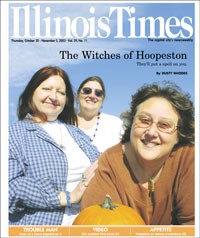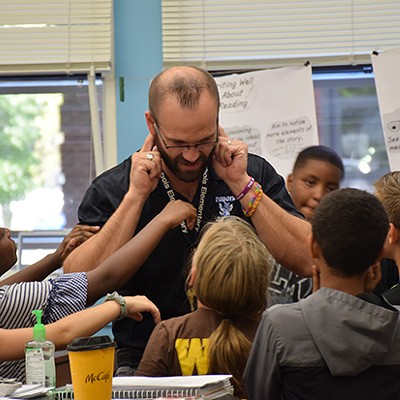Under a sky blackened by the new moon, witches invaded downtown Hoopeston. From as far away as Canada, New York and Colorado, they came wearing black robes festooned with mystic symbols. To celebrate the Pagan holiday Samhain, they feasted on slaughtered animals. Then the Archpriest and High Priestess summoned The Spiritsand channeled otherworldly messages.
And that's about as far as anybody can stretch a stereotype and make it fit the witches of Hoopeston.
What really happened was more like this: A few dozen Wiccans convened for a weekend workshop, capped by a Saturday night Halloween (Samhain) party. Some wore elaborate, often comical costumes; most just threw a cloak over their sweatshirt and jeans. They ate hotdogs and hamburgers, washed down with bargain-brand Sam's Choice soda, danced a few dances and held a short ritual in which yes, they received messages from The Spirits.
"They're normal. They're just like everybody else," says Mary Ann Kaufman, a Hoopeston native who has gotten an up close and personal view of these Wiccans by working part-time at their metaphysical bookstore.
"Normal" isn't normally news. But it is in Hoopeston, a town of 6,000 a few miles north of Danville on the Indiana border. Locals there feared the arrival of the Wiccans meant all Hell would break loose -- literally.
It all started this summer, when Ruthann Amarteifio was leafing through a real estate magazine and came across a property she wanted to buy. It was a 102-year-old structure that had once been Hoopeston's town hall. Instantly, Amarteifio realized this building could serve as a physical campus for her colleagues' school, which at the time existed only online. What really caught Amarteifio's eye was the 130-seat theater with its 450 square-foot stage -- perfect for broadcasting lectures via the Internet. All this for an advertised price of only $40,000. Amarteifio and her colleagues, Don Lewis and Ed Hubbard, obtained a contract, with a closing date set for July 7.
But before you could say abracadabra, word got around that Amarteifio wasn't just your average real estate investor -- she's the founder and High Priestess of the Akasha Temple, a Wiccan group in Kankakee. Hubbard co-founded a Chicago Wiccan group called Holy City Temple, as well as the Pagan Interfaith Embassy, an organization with the goal of fostering cooperation among Pagan sects.
As for Lewis, he's the Archpriest of the Correllian Tradition, a Wiccan denomination established in the 1800s by Cherokees who intermarried with Scottish witches. A direct descendant of the founding family, the High-Corrells, Lewis's online biography describes how his mother gave him his first Tarot deck (the Hoi Polloi) at the tender age of 11.
And who knew what they planned to do in the town hall? The logo of the online educational institution this trio planned to physically transplant to Hoopeston features a crudely-made straw broom underlying the words WitchSchool.com. It has some 60,000 students worldwide.
The locals didn't need a crystal ball to see what was ahead if they let these witches move in to Hoopeston: Nothing but double, double, toil and trouble.
Hoopeston Police Chief Mark Drollinger took the standard law enforcement approach and checked with other municipalities with significant Paganpopulations. "There's never been any reported problems or crop circles or anything like that," he says. Still, he was hearing all sorts of scary tales. "Everyone made all these rash stories about how they were going to snatch children off the street, violate life and limb, commit crime night and day. So at that point, I asked them to come speak at our Neighborhood Watch group."
Problem was, the Neighborhood Watch didn't have another meeting scheduled until August. Meanwhile, a Methodist ministerorganized a community meeting for people to pray for the witch school to not open. A petition opposing sale of any property to facilitate the teaching of witchcraft gathered almost 400 signatures. It was presented to the Hoopeston City Council on July 1. The witches weren't even on the agenda, but that didn't stop scores of skeptics from showing up to ask the council to keep the witches away.
Drollinger attended, alone and wearing civilian clothes. At the end, he escorted the five witches to their car for their own safety.
"It was tense," Drollinger recalls.
Amarteifio has a more vivid recollection. For the first time in the more than 15 years she has lived as a publicly practicing Pagan, she felt physically threatened by Christians.
"I was afraid that night," she says. "I have never ever been in the closet; I've always been out. When I lived in Chicago, my name, my address was published a lot, and I never had any kind of fear.
"One of the guys screaming at us said, 'So who do you have here to support you?' And you could've heard a pin drop. There we were, the five of us, with waves of black stuff coming toward us."
The next day, the newspaper in Champaign quoted the Methodist pastor Timothy Kovalcik, organizer of the prayer vigil, crediting divine intervention for sending the witches away. "When Christians pray, things happen," he said.
It's hard to see anything scary about the witches once you meet them face-to-face. Amarteifio, with her long red hair and flannel shirt, looks like somebody's favorite aunt, the one who would let you eat ice cream for dinner and stay up past your bedtime. Hubbard, with his curls and glasses, looks like a computer geek, which, as it happens, he is. And Lewis, the highest-ranking Wiccan cleric at the Witches Ball, has long hair, a goatee, glasses, and, like a lot of folks, an extra layer of insulation on his body. He sports a black T-shirt promoting something called the Goddess 2000 Project.
"You're a High Priest?" I ask him.
"I am a high priest," he says. "Actually, technically, an Archpriest."
"So what am I supposed to call you?"
"Don."
There is nothing even remotely intimidating about him. The only thing wicked about Lewis, the Archpriest -- Don -- is his wit. In describing how he receives messages from The Spirits, for example, he emphasizes that it's a simple process of relaxing the mind. "It does not involve the Spirit entering your body ooga booga ooga booga," he says.
Wicca is the modern version of nature-based, pre-Christian religions (they don't believe in Satan). The cardinal law of Wicca is simply "harm none," followed by a belief that what goes around comes around. Correllian Wiccans, like those in Hoopeston, are known for emphasizing channeling, or connection with Spirits.
The obvious question is: If they're so connected, why didn't The Spirits warn them that there would be an uprising in Hoopeston?
"The Spirits were gung-ho for it," Lewis says. "Even when it looked like we weren't going to be here, they were still saying that we would. The spiritual end of things was still very positive about us being here."
As it turned out, The Spirits might have been right. At the contentious City Council meeting, the police chief noticed something odd. "The fact that kind of jumped out at me was that half the people there I didn't recognize," says Drollinger, a lifelong Hoopestonian. "Several people there I'd never seen before. And they voiced most of the opposition."
As the witches fled toward Lewis's hometown, Danville, their cell phones started ringing.
"Before we got out of town that night, people were calling to apologize," Amarteifio says. "They are still coming in the store and saying, 'We're so sorry we didn't speak up, but we were afraid.' "
The real turning point came a few weeks later, when the witches went to the Neighborhood Watch meeting and met the real locals. The meeting gave Hubbard the courage to rent a storefront and open a used bookstore, which the witches call The Broom Closet. More recently, they signed a long-term lease on a century-old livery stable just across the street from the Hoopeston Civic Center.
There was much painting and repair to be done before the workshop, which they held in the building's small front rooms. In the cavernous space in the back, they simply added fake cobwebs to the genuinely rustic décor, set up tables and a sound system and had a party. Next year, the Witches Ball will be a fundraiser. This year, they say, it's their "settling in."
"Certainly there are people here who are not happy to see us," Lewis admits. "But there are other groups who have been very welcoming and very nice. The community is lovely, just as we expected."
As the witches gather for the Ball, the scene is akin to a family reunion, with people connecting after long spells apart. Amarteifio keeps snacking to stay connected to the physical world, instead of succumbing to the "light trance" that accompanies communion with The Spirits. "The energy is very strong this weekend because we're all together, and The Spirits are happy," she says. "If I don't keep myself grounded, I'll go flying away."
Other methods for "grounding" include "coffee and giggles."
As the party gets rolling, a gift arrives -- a beautifully carved jack-o'-lantern, a work of art, sent by the tavern across the street.
Mary Ann Kaufman exists between two worlds. Not the physical and the spiritual, but the world of Hoopeston and the world of the witches. She works several days a week in The Broom Closet, and spends the rest of her time taking care of her 81-year-old mother. This schedule suits her and her employer perfectly. "I don't think it was an accident; I think it was supposed to happen," she says.
Some Sundays, when she takes her mother to the Lutheran church, Kaufman fields questions about her job.
"A few people have said, 'You're going to turn into one of them.' And you know, you don't really turn into them," Kaufman says. "But for the most part, even at church, I get, 'Well, how interesting!' and 'What are they like?' There's more curiosity than there is animosity.
"And to me, if you're really a Christian, you should be tolerant," she says. "I think the people causing all the trouble here must be very insecure if they're threatened by this, because these people -- they care about the earth, they care about their environment, they care about other people -- how is that different?
"I've always had an open mind. I've always been open to other religions, be it Buddhists or Pagans or Muslims or anything. I think everybody has their own path to go."





















